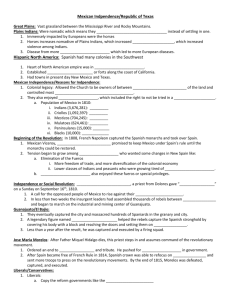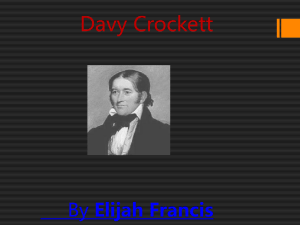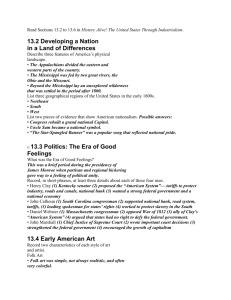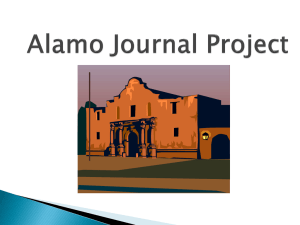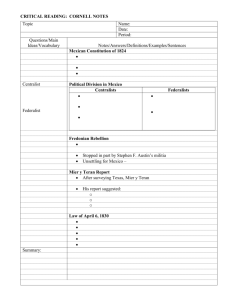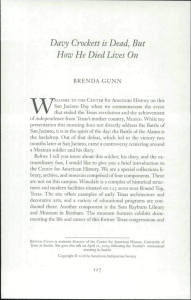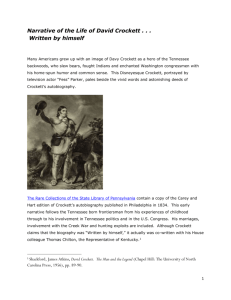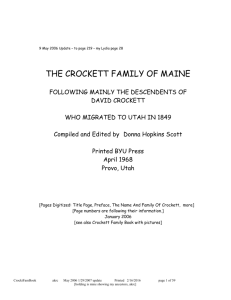o All information is 100% accurate (1 pt)
advertisement
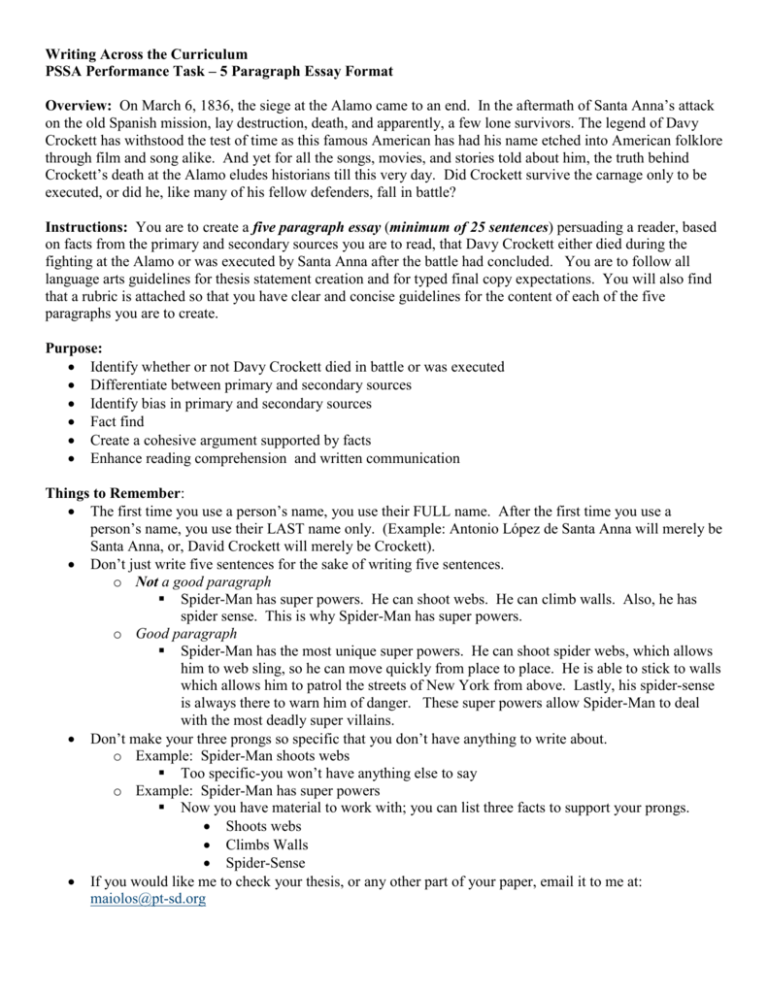
Writing Across the Curriculum PSSA Performance Task – 5 Paragraph Essay Format Overview: On March 6, 1836, the siege at the Alamo came to an end. In the aftermath of Santa Anna’s attack on the old Spanish mission, lay destruction, death, and apparently, a few lone survivors. The legend of Davy Crockett has withstood the test of time as this famous American has had his name etched into American folklore through film and song alike. And yet for all the songs, movies, and stories told about him, the truth behind Crockett’s death at the Alamo eludes historians till this very day. Did Crockett survive the carnage only to be executed, or did he, like many of his fellow defenders, fall in battle? Instructions: You are to create a five paragraph essay (minimum of 25 sentences) persuading a reader, based on facts from the primary and secondary sources you are to read, that Davy Crockett either died during the fighting at the Alamo or was executed by Santa Anna after the battle had concluded. You are to follow all language arts guidelines for thesis statement creation and for typed final copy expectations. You will also find that a rubric is attached so that you have clear and concise guidelines for the content of each of the five paragraphs you are to create. Purpose: Identify whether or not Davy Crockett died in battle or was executed Differentiate between primary and secondary sources Identify bias in primary and secondary sources Fact find Create a cohesive argument supported by facts Enhance reading comprehension and written communication Things to Remember: The first time you use a person’s name, you use their FULL name. After the first time you use a person’s name, you use their LAST name only. (Example: Antonio López de Santa Anna will merely be Santa Anna, or, David Crockett will merely be Crockett). Don’t just write five sentences for the sake of writing five sentences. o Not a good paragraph Spider-Man has super powers. He can shoot webs. He can climb walls. Also, he has spider sense. This is why Spider-Man has super powers. o Good paragraph Spider-Man has the most unique super powers. He can shoot spider webs, which allows him to web sling, so he can move quickly from place to place. He is able to stick to walls which allows him to patrol the streets of New York from above. Lastly, his spider-sense is always there to warn him of danger. These super powers allow Spider-Man to deal with the most deadly super villains. Don’t make your three prongs so specific that you don’t have anything to write about. o Example: Spider-Man shoots webs Too specific-you won’t have anything else to say o Example: Spider-Man has super powers Now you have material to work with; you can list three facts to support your prongs. Shoots webs Climbs Walls Spider-Sense If you would like me to check your thesis, or any other part of your paper, email it to me at: maiolos@pt-sd.org Name:___________________________________________ Grade Sheet for PSSA Social Studies Writing Prompt Paragraph 1: Introduction Thesis is a three pronged thesis statement (1 pt) Thesis is the last sentence of the opening paragraph (1 pt) All information is 100% accurate (1 pt) Paragraph contains at least 5 sentences (1 pt) Zero spelling or punctuation mistakes (1 pt) Paragraph 2: Body 1st piece of evidence to support the first prong of the thesis is 100% accurate (1 pt) 2nd piece of evidence to support the first prong of the thesis is 100% accurate (1 pt) 3rd piece of evidence to support the first prong of the thesis is 100% accurate (1 pt) Zero spelling or punctuation mistakes (1 pt) Paragraph contains at least 5 sentences (1 pt) Paragraph 3: Body 1st piece of evidence to support the second prong of the thesis is 100% accurate (1 pt) 2nd piece of evidence to support the second prong of the thesis is 100% accurate (1 pt) 3rd piece of evidence to support the second prong of the thesis is 100% accurate (1 pt) Zero spelling or punctuation mistakes (1 pt) Paragraph contains at least 5 sentences (1 pt) Paragraph 4: Body 1st piece of evidence to support the third prong of the thesis is 100% accurate (1 pt) 2nd piece of evidence to support the third prong of the thesis is 100% accurate (1 pt) 3rd piece of evidence to support the third prong of the thesis is 100% accurate (1 pt) Zero spelling or punctuation mistakes (1 pt) Paragraph contains at least 5 sentences (1 pt) Paragraph 5: Conclusion Re-statement of thesis-“in other words” (synonyms) (1 pt) All information is 100% accurate (1 pt) Paragraph contains at least 5 sentences (1 pt) Zero spelling or punctuation mistakes (1 pt) Other: NO PERSONAL PRONOUNS (NO “I, you, we, us, our, etc.”) (1 pt) Double spaced (1 pt) Times New Roman Font-size 12 (1 pt) ______/27 David Crockett’s Mysterious Death On March 6, 1836, the famous siege at the Alamo came to both a sad and historical end for those fighting to achieve Texan independence. More than a thousand Mexican troops under the command of General Antonio López de Santa Anna stormed the old Spanish mission killing all 180 defenders. Amongst those that lay among the deceased were the famous knife fighter, Jim Bowie, the commander of the garrison, William Travis, and the famed frontiersman David Crockett. Historians have written countless pages about this famous siege, Hollywood has embraced the fallen heroes in numerous films, and the battle cry “Remember the Alamo!” is still taught to school children today. Yet, with all that has been written about the Alamo in the past 175 years there is still major controversy surrounding that day—how exactly did the most famous defender, Davy Crockett, meet his demise? Did Crockett die in the melee of battle, or did he survive the carnage only to be executed? Historians have tried to find facts supporting both theories, but as author Stephen Harrigan states, “it is not an easy thing to get the facts straight when there are almost no straight facts, when the real story has been buried in so many layers of myth and countermyth as to be nearly irretrievable.”1 Historian Michael Lind attempts to clarify the problem of Crockett’s death by breaking down the controversy into two theories: the corroboration (cor·rob·o·ra·tion) theory and the contamination theory. According to Lind, the corroboration theory “holds that all of the accounts of Crockett’s execution reflect a real event; any differences among them can be attributed to confusion and the vagaries of memory.”2 Thus, those that believe in the corroboration theory believe Crockett was indeed executed, even though there are different versions of the same event. In contrast to the corroboration theory, the contamination theory “holds that the story of Crockett’s execution was an erroneous rumor, which made its way into Texan and American newspapers and thence into memoirs written later by both North Americans and Mexicans.”3 Thus, historians are divided amongst those that believe Crockett died during the fighting (the contamination theory) and those that argue that Crockett was captured along with five or six others, and then sentenced to death by Santa Anna (the corroboration theory). There is a third theory, but it is safe to say that it is merely folklore, as it has Crockett surviving the battle and being forced to work as a slave in a Mexican mine.4 The piece of evidence most used by historians to attempt to find the truth about Crockett’s death is the manuscript of Jòse Enrique de la Peña (Appendix A). Professor James E. Crisp notes that the de la Peña manuscript is actually two pieces. The first piece is de la Peña’s diary (this section of the manuscript does not mention Crockett’s name). De la Peña then took his diary and created an “extended narrative supplemented with information…gathered after the [battle].”5 However even with the manuscript identified as two separate pieces, there are still three possible flaws surrounding de la Peña’s work. First and foremost, historians question whether or not de la Peña’s manuscript could be a forgery. Secondly, if the work is real, is de la Peña telling the truth? And lastly, did de la Peña even know who David Crockett was?6 1 Stephen Harrigan, "Davy Crockett and the Alamo: Thoughts on Truth, Fiction, and Smelling a Rat," The Magazine of Western History 50, no. 3 (Fall 2000): 58-59. 2 Michael Lind, "The Death of David Crockett," The Wilson Quarterly 22, no. 1 (Winter 1998): 52. 3 Ibid. 4 Thomas Lawrence Connelly, "Did David Crockett Surrender at the Alamo? A Contemporary Letter," The Journal of Southern History 26, no. 3 (August 1960): 371. 5 David B. Gracy II, "'Just as I have Written It': A Study of the Authenticity of the Manuscript of Jose Enrique de la Pena," The Southwestern Historical Quarterly 105, no. 2 (October 2001): 255. 6 Lind, 52. There are three reasons why some historians believe de la Peña’s manuscript to be a forgery. These historians question the content of the manuscript and how some of the facts do not appear to be entirely accurate. Secondly, de la Peña’s manuscript was originally written in Spanish and had to be translated into English. Historians question the accuracy and quality of the translation. And lastly, since the manuscript appears to be both a diary and a memoir, historians question the very nature of the document.7 In 2000, David B. Gracy II, professor and director of the Center for the Cultural Record and Graduate School of Library and Science at the University of Texas at Austin, undertook the task of validating whether or not the de la Peña manuscript was real or was a forgery. Here were his findings: (1) The physical characteristics of the Peña document conform to the characteristics known and expected of documents of the period of the 1830s and 1840s in which the manuscript purportedly was written. (2) No physical characteristic of paper, ink, and condition of the document alone, and especially none of them in combination, point to the Peña document being a twentieth-century forgery of an item dating from the period of the 1830s and 1840s. (3) Neither does the penmanship exhibit signs of forgery….More importantly the characteristics of the penmanship at critical points in the document correspond to those exhibited in unquestioned examples of Peña’s handwriting.8 Even with Gracy’s use of modern science to validate the authenticity of de la Peña’s manuscript, some historians are still skeptical that it is actually not a forgery. De la Peña’s manuscript is written in two different types of handwriting. (Gracy acknowledges this fact but counters it by pointing out that creating two different types of handwriting only makes the creation of the forgery more complex and would draw greater scrutiny to the document being forged).9 Furthermore, forging historical documents is not all that uncommon. Forgers have created such documents as an Adolf Hitler diary and even letters linking John F. Kennedy to Marilyn Monroe and the mafia.10 The de la Peña manuscript is not the only piece of evidence that tells the story of Crockett’s execution. George M. Dolson (Appendix B), a Texan officer and interpreter at a prisoner-of-war camp for Mexican soldiers, also contributes to the belief that Crockett was executed. Dolson was asked to translate a statement from a Mexican officer that had witnessed the executions ordered by Santa Anna at the Alamo. Historian James E. Crisp argues that “The [Mexican] officer described Crockett’s death, giving details of the scene that were confirmed the following year when Santa Anna’s personal secretary, Ramòn Martìnez Caro (Appendix C), published an account of the incident….”11 (Even though the Caro account corroborates with Dolson’s letter, Caro does not mention any names of those that were executed). Dolson then wrote a letter to his brother in which he re-told the story Dolson had translated for the Mexican soldier. Other contemporary accounts lead historians down a different path in terms of finding the truth of Crockett’s death. Susannah Dickinson, a widow of one of the defenders, and Joe, Travis’s slave, both stated they saw Crockett’s body where it had fallen- in combat. In fact, none of the contemporary accounts coming out of Texas identified Crockett as one of the executed. Instead, many of the accounts actually had Travis or Bowie or both men committing suicide after they believed the battle to be lost. As months passed from the actual date of the Alamo, the accounts began to state that either Crockett, Bowie, Travis, or all three were actually executed by Santa Anna. The New Orleans True American printed the following story from Andrew 7 Gracy II, 256-257. Ibid., 291. 9 Ibid., 290. 10 Ibid., 258-259. 11 James E Crisp, "Crockett Controversy Continues." The Wilson Quarterly 22, no. 2 (Spring 1998): 7. 8 Briscoe, a Texas settler, a few weeks after the battle, “Colonels James Bowie and Crockett were among the slain; the first was murdered in his bed in which he had been confined by sickness. The later [sic] fell fighting like a tiger.”12 Stephen Harrigan was correct, the truth about David Crockett is indeed buried in myth. Was the famed frontiersman executed or did he go out “fighting like a tiger?” There is certainly evidence supporting both stories, and yet the evidence still leaves doubt in historians’ minds as they continue to debate the demise of the “king of the wild frontier.” 12 Lind, 54. (Appendix A) Jòse Enrique de la Peña Memoir Some seven men had survived the gener-al carnage and, under the protection of General Castrillon, they were brought before Santa Anna. Among them was one of great stature, well proportioned, with regular features, in whose face there was the imprint of adversity,b ut in whom one also noticed a degree of resignation and nobility that did him honor. He was the naturalist David Crockett, well known in North America for his unusual adventures, who had undertaken to explore the country and who, finding himself in Bejar at the very moment of surprise, had taken refuge in the Alamo, fearing that his status as a foreigner might not be respected. Santa Anna answered Castrillon's inter-vention in Crockett's behalf with a gesture of indignation and, addressing himself to the sappers, the troops closest to him, ordered his execution. The commanders and officers were outraged at this action and did not support the order, hoping that once the fury of the moment had blown over these men would be spared; but sev-eral officers who were around the presi-dent and who, perhaps, had not been pre-sent during the moment of danger, became noteworthy by an infamous deed, surpassing the soldiers in cruelty. They thrust themselves forward, in order to flat-ter their commander, and with swords in hand, fell upon these unfortunate, defenseless men just as a tiger leaps upon his prey. Though tortured before they were killed, these unfortunates died with-out complaining and without humiliating themselves before their torturers. It was rumored that General Santa Anna was one of them; I will not bear witness to this, for, though present, I turned away horrified in order not to witness such a barbarous scene. (Appendix B) George M. Dolson Letter I am employed a considerable part of my time in interpreting Spanish for Colonel James Morgan,14 commander of this station. He sent for me yesterday and told me there was a communication of importance from one of Santa Anna's officers, which he wished me to interpret; accordingly the officer of the day was dispatched for the Mexican officer, who came in in a few minutes, and the Colonel's quarters were vacated of all, save us three. The Mexican was then requested to proceed with the statement ac-cording to promise; and he said he could give a true and correct account of the proceedings of Santa Anna towards the prisoners who remained alive at the taking of the Alamo. This shows the fate of Colonel Crockett and his five brave companions-there have been many tales told, and many suggestions made, as to the fate of these patriotic men; but the following may be relied on, being from an individual who was an eye witness to the whole proceedings. The Colonel has taken the whole in writing, with the officer'sn ame attached to it, which he observedt o him, if he had the least delicacy, he might omit, but he said he had not and was willing to be qualified to it in the presence of his God, and General Santa Anna, too, if necessary. He states that on the morning the Alamo was captured, between the hours of five and six o'clock, General Castrillon, who fell at the battle of San Ja-cinto, entered the back room of the Alamo, and there found Crockett and five other Americans, who had defended it until defence was useless; they appeared very much agitated when the Mexican soldiers undertook to rush in after their General, but the humane General ordered his men to keep out, and, plac-ing his hand on one breast, said, "here is a hand and a heart to protect you; come with me to the General-in Chief, and you shall be saved." Such redeeming traits, while they ennoble in our es-timation this worthy officer, yet serve to show in a more heinous light the damning atrocities of the chief. The brave but unfortu-nate men were marched to the tent of Santa Anna. Colonel Crockett was in the rear, had his arms folded, and appeared bold as the lion as he passed my informant (Almonte.) Santa Anna's interpreter knew Colonel Crockett, and said to my in-formant," the one behind is the famous Crockett."W hen brought in the presence of Santa Anna, Castrillon said to him, "Santa Anna, the august, I deliver up to you six brave prisoners of war." Santa Anna replied, "who has given you orders to take prisoners, I do not want to see those men living-shoot them." As the monster uttered these words each officer turned his face the other way, and the hell-hounds of the tyrant despatched the six in his presence, and within six feet of his person. Such an act I consider murder of the blackest kind. Appendix C Ramòn Martìnez Caro Among the 183 killed there were five who were discovered by General Castrillon hiding after the assault. He took them immediately to the presence of His Excellency who had come up by this time. When he presented the prisoners he was severely reprimanded for not having killed them on the spot, after which he turned his back upon Castrillon while the soldiers stepped out of their ranks and set upon the prisoners until they were all killed. . . . We all witnessed this outrage which humanity condemns but which was committed as described. This is a cruel truth, but I cannot omit it.
